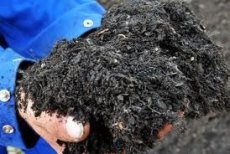New publications
Composting - a new way of environmentally friendly burial of the dead
Last reviewed: 02.07.2025

All iLive content is medically reviewed or fact checked to ensure as much factual accuracy as possible.
We have strict sourcing guidelines and only link to reputable media sites, academic research institutions and, whenever possible, medically peer reviewed studies. Note that the numbers in parentheses ([1], [2], etc.) are clickable links to these studies.
If you feel that any of our content is inaccurate, out-of-date, or otherwise questionable, please select it and press Ctrl + Enter.

Many cultures and religions preserve the bodies of the deceased through embalming or burial, but some environmentalists have proposed so-called composting of the dead, which would replace current burial practices with a more natural method.
From an environmental perspective, current methods of burying the dead (in a coffin or underground crypt) take up a fairly large amount of space and use unstable materials (for example, wood, steel, etc.). This is especially true for densely populated regions where land is a limited resource.
Also, in the process of burial, auxiliary materials (flowers, clothes, etc.) are often used, which are initially extracted from the surrounding world, properly prepared, transported, but after the funeral, almost all additional materials disappear from the lives of relatives and loved ones of the deceased. At first glance, such reasoning can be criticized, but upon closer examination, it is clear that the process of traditional burial requires a huge amount of resources. For example, in the United States of America, more than one and a half million hectares of trees and more than 90 tons of steel are used each year to make coffins. About 3.5 million liters of formaldehyde are used annually during embalming, and fossil fuels are required for cremation.
Even after death, the body continues to emit a carbon footprint, and there have been numerous proposals for eco-friendly burial methods. For example, it has been suggested to use more eco-friendly materials for coffins or to make a portrait of the deceased from their ashes, but a new project called “Urban Death” involves closing the human life cycle on earth.
The author of the project was Katrina Spade, who called her work a new system for the careful and secure burial of the dead using a new composting method.
Katrina Spade's work involves a safe and secure means of burying bodies in soil-building materials that will later be used for homesteads, gardens, or nearby farms. Spade's project reverses the common practice of polluting and wasting the environment.
The new type of burial basically contains a multi-stage device that acts as a large-scale composter, in which the body is transformed, along with sawdust, wood chips and other materials, into a concentrated fertilizer, while at the same time the composter serves as a place for the mourning of loved ones.
First, the body of the deceased is placed at the top of the composter and covered with wood chips, sawdust, etc., where the process of decomposition and settling takes place over the course of a month, after which the mass turns into concentrated fertilizer.
Relatives and friends can take the fertilizer and use it for their gardens or summer cottages. As a result, the deceased relative seems to always be nearby.
Katrina Spade received $80,000 from Echoing Green this summer to develop her project, and she is currently busy building her first prototype in Seattle. Once Spade's prototype is up and running, she will look for a location to launch the full version of Urban Death and help anyone who wants to do one last green thing in their life.
 [ 1 ]
[ 1 ]
